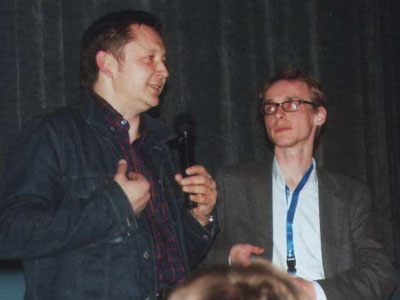
Der Regisseur Stanislaw Mucha und ich letzten Monat im Filmgespräch zu seiner Doku-Comedy. Die Mitte hat er in dem Gespräch für sich beansprucht. Regisseure sind meist halt auch nur Rampensäue, aber irgendwer muss die Bestien ja zähmen ;-)
|
... mal eine kleine Perle aus meinem geheimen Fotoalbum:
 Der Regisseur Stanislaw Mucha und ich letzten Monat im Filmgespräch zu seiner Doku-Comedy. Die Mitte hat er in dem Gespräch für sich beansprucht. Regisseure sind meist halt auch nur Rampensäue, aber irgendwer muss die Bestien ja zähmen ;-)
...1293x geklickt ...mehr Photos
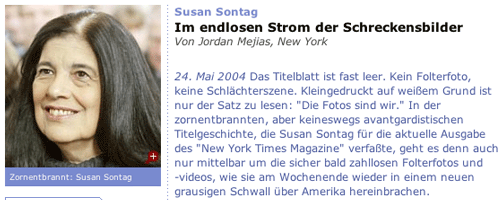 Ich habe schon Bilder von ihr gesehen, die man eher als "zornentbrannt" hätte untertiteln können. "Es fehlte etwas, wenn man, nachdem man nackte Männer aufeinandergestapelt hätte, nicht ein Foto von ihnen machen könnte." Hinzu komme, daß bei immer mehr Leuten das erotische Leben darin bestehe, was in digitalen Fotos oder Videos festzuhalten sei. Mit Sex werde Folter wohl nur attraktiver, sammelnswerter. Folter wie Pornographie aber verankert Sontag direkt im amerikanischen Alltag, in der zunehmenden Akzeptanz der Brutalität und Verrohung des Gefühlslebens einer Gesellschaft, die sich im Fernsehen exhibitionistisch in einer "Kultur der Schamlosigkeit" ergeht und "die Phantasien und die Praxis der Gewalt als gute Unterhaltung, als Fun" ansieht. (Im endlosen Strom der Schreckensbilder, FAZ 24.5.2004) Ich bin mir sicher, das es eher was mit dem Motiv der Jagdtrophäen zu tun hat. Aber jetzt muss ich erstmal mein altes NYT-Passwort finden, bevor ich ihren Text im Original lesen kann. Nachtrag (28.5.2004): Einige Auszüge aus dem Artikel von Susan Sontag (New York Times, 23. Mai 2004 login erforderlich), die ich interessant finde: Sontag geht u.a. auch auf frühere Fotos ein, in denen sie auch das Motiv der Trophäe erkennt: "[...] photographs of black victims of lynching taken between the 1880's and 1930's, which show Americans grinning beneath the naked mutilated body of a black man or woman hanging behind them from a tree. The lynching photographs were souvenirs of a collective action whose participants felt perfectly justified in what they had done. So are the pictures from Abu Ghraib. The lynching pictures were in the nature of photographs as trophies -- taken by a photographer in order to be collected, stored in albums, displayed. The pictures taken by American soldiers in Abu Ghraib, however, reflect a shift in the use made of pictures -- less objects to be saved than messages to be disseminated, circulated. A digital camera is a common possession among soldiers. Where once photographing war was the province of photojournalists, now the soldiers themselves are all photographers -- recording their war, their fun, their observations of what they find picturesque, their atrocities -- and swapping images among themselves and e-mailing them around the globe. [...]" Diesen Wechsel der Motivation der Bilder verstehe ich noch nicht so ganz. Die Trophäe hat den Zweck, eine Tat zu belegen und mit Stolz anderen zu zeigen. Nur das jetzt die Täter selber fotographieren und nicht mehr ein professioneller Fotojournalist, soll etwas in der Funktion des Bildes bewirken? Zumal sie später in ihrem Artikel auch darauf eingeht, ob diese aktuellen Folterfotos tatsächlich "privat" von Individuen gemacht wurden, oder ob die Foltertaten von offizieller Seite instruiert sind und einige der Bilder sogar wie von professionellen Fotografen scheinen. Aber das Problem ist ja nicht das Bild, sondern was es darstellt. Und das, was allgemein in Fotos und Aufnahmen dargestellt wird, ändert sich (und daran beteiligen sich übrigens Weblogbetreibende ja auch): "There is more and more recording of what people do, by themselves. At least or especially in America, Andy Warhol's ideal of filming real events in real time [...] has become a norm for countless Webcasts, in which people record their day, each in his or her own reality show. [...] People record all aspects of their lives, store them in computer files and send the files around. Family life goes with the recording of family life -- even when, or especially when, the family is in the throes of crisis and disgrace. [...] Soweit, so gut. Weiter argumentiert Sontag, mit der Gewöhnung an die Dokumentation und Privatveröffentlichung des alltäglichen Lebens im Bilde ändert sich auch die Hemmschwelle der Darstellung von Sexualität in der Öffentlichkeit. Und an der Verknüpfung der Folter mit pornographischen Bildthemen erkennt Sontag das eigentliche Problem: [...] An erotic life is, for more and more people, that which can be captured in digital photographs and on video. And perhaps the torture is more attractive, as something to record, when it has a sexual component. It is surely revealing, as more Abu Ghraib photographs enter public view, that torture photographs are interleaved with pornographic images of American soldiers having sex with one another. In fact, most of the torture photographs have a sexual theme, as in those showing the coercing of prisoners to perform, or simulate, sexual acts among themselves. One exception, already canonical, is the photograph of the man made to stand on a box, hooded and sprouting wires, reportedly told he would be electrocuted if he fell off. Yet pictures of prisoners bound in painful positions, or made to stand with outstretched arms, are infrequent. That they count as torture cannot be doubted. You have only to look at the terror on the victim's face, although such ''stress'' fell within the Pentagon's limits of the acceptable. But most of the pictures seem part of a larger confluence of torture and pornography: a young woman leading a naked man around on a leash is classic dominatrix imagery. And you wonder how much of the sexual tortures inflicted on the inmates of Abu Ghraib was inspired by the vast repertory of pornographic imagery available on the Internet -- and which ordinary people, by sending out Webcasts of themselves, try to emulate. [...] Auch da verstehe ich was nicht. Folter ist Folter und Scheisse. Ist Folter mit sexueller Implikation noch scheisserer? Wären die Folterbilder ohne sexuelles Motiv weniger schlimm? Ich glaube, ich find's ein bißchen reißerisch. Aber an sich stimmt's schon irgednwie. Ist was anderes, als frühere Trophäenfotographie. Und diesen Unterschied macht Sontag hier nochmal deutlich: [...] To live is to be photographed, to have a record of one's life, and therefore to go on with one's life oblivious, or claiming to be oblivious, to the camera's nonstop attentions. But to live is also to pose. To act is to share in the community of actions recorded as images. The expression of satisfaction at the acts of torture being inflicted on helpless, trussed, naked victims is only part of the story. There is the deep satisfaction of being photographed, to which one is now more inclined to respond not with a stiff, direct gaze (as in former times) but with glee. The events are in part designed to be photographed. The grin is a grin for the camera. There would be something missing if, after stacking the naked men, you couldn't take a picture of them." Ja, für Sontag sind diese Folterbilder scheisserer, weil sie eine lustvolle Befriedigung durch die sexuelle Unterdrückung aufzeigen. Für mich bleibt die Motivation der Trophäe, und die war auch früher schon lustvoll motiviert, denke ich. Das eine Verschärfung der Darstellung durch gesellschaftliche Abstumpfung eingetreten ist, ist natürlich ein wichtiges Indiz, aber ich sehe prinzipiell keinen Unterschied in früheren Bildern, die ebenso den Zweck hatten, Dominanz über ein diskriminiertes "Anderes" / "Fremdes" zu representieren. Aber mehr als "die Bilder sind wir" will sie eigentlich auch nicht sagen. Also kollektive Anklage und nicht geschmackloser Fehltritt Einzelner.
...1781x geklickt ...mehr Photos
 http://www.billowens.com - Fotos aus amerikansichen Suburbs, frühe 70er. Für Interieur-Fans und Freunde der Familienidylle. Mehr Fotos aus Suburbia (via: erratika)
...1205x geklickt ...mehr Photos
Zu meinem Geburtstag hatte ich von einer Ex-Kommolitonin einen Stadionbesuch geschenkt bekommen. Und am letzten Samstag war es dann so weit: mein erstes Fußballspiel in echt. Hertha BSC gegen Dortmund BVB. Und ich hatte ja keine Ahnung - sowieso über Fußball und speziell wie das dann rockt. Und dann auch noch 8 Tore in einem Spiel. War der Hammer!
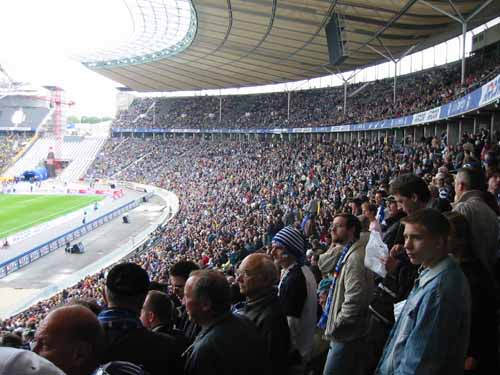 Beim Reinkommen diese Ansicht. Man kennt diese Art Bilder ja aus dem Fernsehen. In echt ist das dann leider schon sehr überwältigend, muss ich gestehen.  Platz gefunden - Block P, Reihe 5 - gleich neben der Ostkurve mit prima Blick auf die Hertha-Fans. 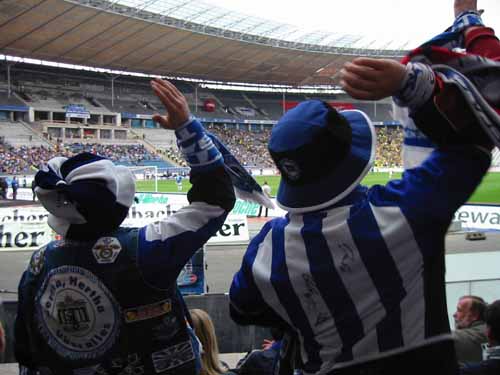 Kurz vorm Spiel erzählte mir eine Polin einen Witz: Warum müssen Deutsche immer zwei Viagra nehmen? - Weil bei einer Viagra immer erst der Arm hoch geht...  Da war dann schon das Spiel zu Ende. Hertha hat mit 6:2 gewonnen. BVB-Fans - gestandene Männer mit Tränen in den Augen. Die anderen mussten sich vor Freude an ihren Schals festhalten. 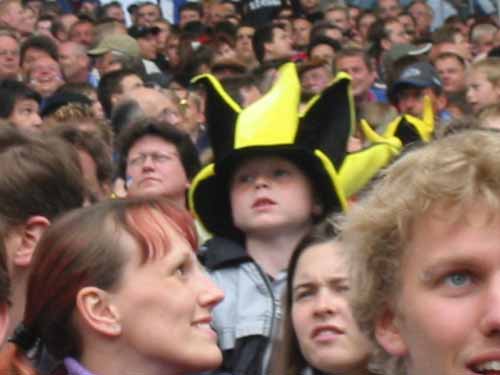 Die kleinen Fans taten mir besonders Leid. Da waren so einige ziemlich traurige Kinder zu sehen. 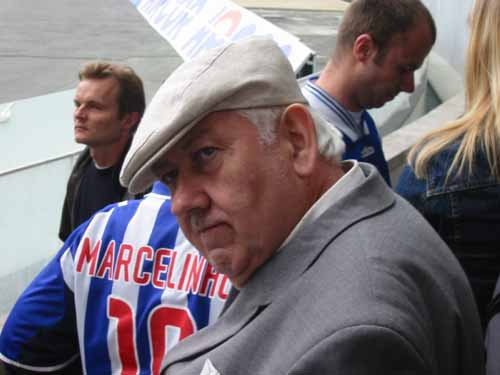 Ihn fand ich klasse. Der hat immer abgewunken, wenn Hertha blöd am Ball rumgefummelt hatte und hat immer die Faust hochgerissen, wenn ein Tor fiehl. Er schien mir der ruhigste im Stadion zu sein.  Er hat immer rumgetrommelt. Mit einem seiner Fan-Kollegen hatte ich kurz nach dem Foto noch eine Diskussion. Die wollten keine Fotos. Haben dann einen BVB-Schal verbrannt. 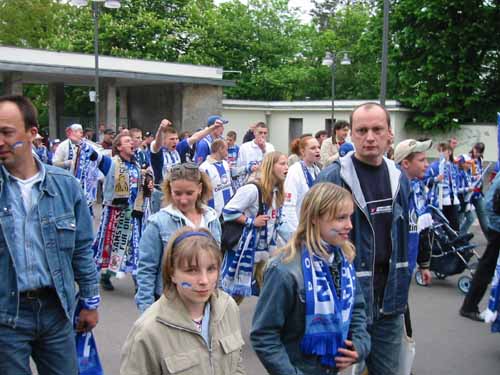 Das Nervigste: Der Rückweg mit der S-Bahn. Man kennt das ja, wenn man da zufällig reingerät. Aber ist eigentlich gar nicht so wild, wie einem das dann immer erscheint. Eine geile Nacht im Club ist wilder.
...1432x geklickt ...mehr Photos
...1233x geklickt ...mehr Photos
...1317x geklickt ...mehr Photos
...1862x geklickt ...mehr Photos
In diesem Zusammenhang (Bilder / Buchstaben) möchte ich mich noch an THE UNTITLED PROJECT erinnern, wo Buchstaben aus Fotos rausgenommen werden.
The Untitled Project is a series of photographs of urban settings accompanied by a graphical text layout. The photographs have been digitally stripped of all traces of textual information. The text pieces show the removed text in the approximate location and font as it was found in the photograph. Da kommen sehr spannende Sachen bei raus.
...2120x geklickt ...mehr Photos

...1140x geklickt ...mehr Photos
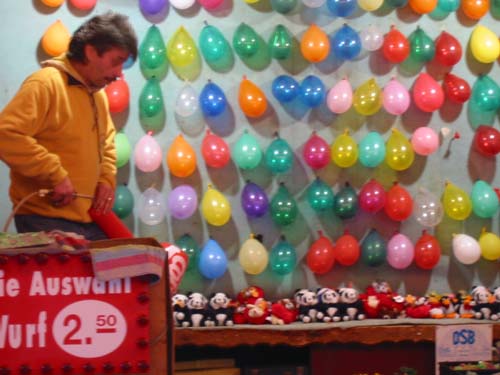
...1205x geklickt ...mehr Photos
|
start | über | themen | klowand | fragen? login Letztes Update: Thu, 11.02.2010, 03:15 Letzte Aktualisierungen
Blog- und Serverumzug
Nach 2311 Tagen auf blogger.de ziehe ich heute um auf... by tristessedeluxe (2010/02/11 03:15) Film: A Serious Man
::: gesehen am 21.1.2010 OmU im Odeon USA 2009 - Regie:... by tristessedeluxe (2010/01/22 04:22) Film: Razzia sur la chnouf
:::: gesehen am 17.1.2010 auf arte(Razzia in Paris)... by tristessedeluxe (2010/01/20 12:39) Neues Open Source Road...
BMW K100 in Zentralrussland, originally uploaded... by tristessedeluxe (2010/01/19 23:14) Meine Social Media Identitäten
Blogroll
|
||
|
|
|||
|
Archiv/ 02/10 / 01/10 / 12/09 / 11/09 / 10/09 / 09/09 / 08/09 / 07/09 / 06/09 / 05/09 / 03/09 / 02/09 / 01/09 / 12/08 / 11/08 / 10/08 / 09/08 / 08/08 / 07/08 / 06/08 / 05/08 / 04/08 / 03/08 / 02/08 / 01/08 / 12/07 / 11/07 / 10/07 / 09/07 / 08/07 / 07/07 / 06/07 / 05/07 / 04/07 / 03/07 / 02/07 / 01/07 / 12/06 / 11/06 / 10/06 / 09/06 / 08/06 / 07/06 / 06/06 / 05/06 / 04/06 / 03/06 / 02/06 / 01/06 / 12/05 / 11/05 / 10/05 / 09/05 / 08/05 / 07/05 / 06/05 / 05/05 / 04/05 / 03/05 / 02/05 / 01/05 / 12/04 / 11/04 / 10/04 / 09/04 / 08/04 / 07/04 / 06/04 / 05/04 / 04/04 / 03/04 / 02/04 / 01/04 / 12/03 / 11/03 / 10/03 /
|
|||
|
Rubriken/ 365 / 9to5 / aus dem Bauch raus / bcberlin3 / behauptungen / Berlin / Blog interna / blog-o-collage / BlogStock / Comics / Computerkram / Fernsehfestspiele / Filme online / Filmkram / Filmtagebuch / Filmvorfuehr-Report / Filmwissenschaft / Geschenke / Impressum / Kinderkram / Kinofriedhof / küchentisch / Laboratorium / langeweile / Lernen fuers Leben / Links / Medienkunst - Theorie / Musikanten / nur so fun / ohne Topic / Photos / podcast / Politik / Private Parts / pssst! / Q & A / Radio / re-publica / re-publica08 / sag' dem Tag leise Abschied / Schnipsel zum Ausschneiden und Sammeln / ThinX in the City / twitter / Umtopfen / Und sonst... / Videocasts / vlog / Webmontag / Weihnachten / WorK.spaCe /
|
|||
|
Letzte Fotos auf flickr /
|